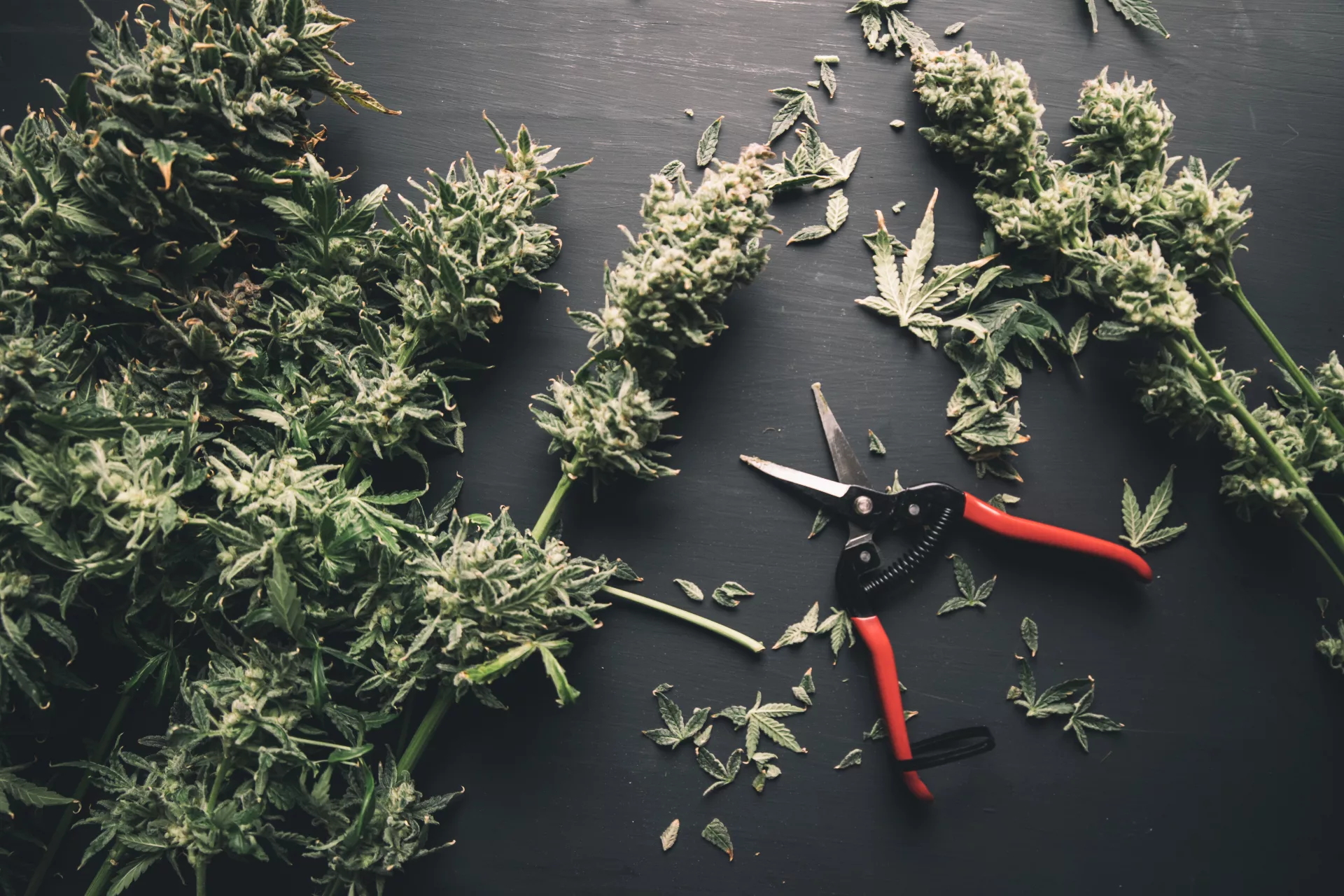
Trimming plays a pivotal role in the cultivation of cannabis, serving as a crucial step in the journey from harvest to consumption. As cannabis plants reach maturity, they develop an abundance of foliage, including large fan leaves that obscure the prized flower buds beneath. Trimming involves the careful removal of excess foliage, allowing cultivators to showcase the full beauty and potency of their harvest. This meticulous process is essential for producing high-quality cannabis that not only looks appealing but also delivers a potent and flavourful experience for consumers.
Trimming is more than just an aesthetic concern; it directly impacts the overall quality of the final product. By meticulously removing excess leaves and stems, cultivators can enhance the appearance, aroma, and potency of their cannabis buds. Furthermore, proper trimming ensures that each bud receives adequate airflow and light exposure during the drying and curing stages, minimizing the risk of mold and mildew development. In essence, trimming is a cornerstone of cannabis cultivation, contributing significantly to the overall success and marketability of a harvest.
In the realm of cannabis trimming, two primary methods stand out: wet trimming and dry trimming. Wet trimming involves trimming the harvested buds immediately after harvest, while they are still moist and sticky. On the other hand, dry trimming entails waiting until the buds have dried to a certain degree before trimming them. Each method offers its own set of advantages and disadvantages, influencing factors such as potency, flavour, and drying time. Understanding the nuances of wet trimming and dry trimming is essential for cultivators seeking to optimize the quality and efficiency of their harvests.
Wet trimming involves the meticulous removal of excess foliage from freshly harvested cannabis buds while they are still moist and sticky. The process typically begins immediately after harvest, when the buds are at their peak freshness. Cultivators carefully manicure each bud, trimming away fan leaves and excess stems to reveal the dense, resinous flowers beneath. Wet trimming requires precision and attention to detail, as the delicate nature of freshly harvested buds demands gentle handling to avoid damaging trichomes or disrupting the bud structure.

Dry trimming involves the meticulous removal of excess foliage from cannabis buds after they have been allowed to dry to a certain degree. Unlike wet trimming, which occurs immediately after harvest, dry trimming takes place once the buds have reached an optimal moisture level for handling. Cultivators carefully manicure each dried bud, trimming away fan leaves and excess stems to enhance the bud’s appearance and potency. Dry trimming requires patience and precision, as the delicate nature of dried buds necessitates gentle handling to avoid damaging trichomes or compromising bud quality.
When deciding between wet and dry trimming methods for your cannabis harvest, several factors must be taken into account. Firstly, consider the scale of your cultivation operation. For smaller-scale home grows with a limited number of plants, wet trimming may be more practical and manageable. With fewer buds to process, home growers can dedicate the time and attention needed to carefully manicure each bud without feeling overwhelmed by the volume of work. Conversely, larger commercial grows with higher volumes of harvested cannabis may benefit from the efficiency and consistency offered by dry trimming methods. Dry trimming allows commercial cultivators to process larger volumes of harvested cannabis more quickly and consistently, streamlining the post-harvest workflow and maximizing productivity.

Another crucial consideration is the desired end product quality. Wet trimming may be preferred for cultivators seeking to preserve the freshness and terpene profile of their harvest. By trimming the buds immediately after harvest, cultivators can lock in the full spectrum of terpenes, resulting in a more aromatic and flavourful final product. On the other hand, dry trimming may be favoured for cultivators prioritizing potency and trichome integrity. Dry trimming helps minimize the risk of trichome loss during the trimming process, ensuring that the final product maintains its potency and market appeal.
Environmental conditions also play a significant role in the choice between wet and dry trimming. In humid climates or environments prone to mold and mildew, wet trimming may pose a higher risk of fungal contamination during the drying and curing stages. Dry trimming, on the other hand, may be more suitable for cultivators operating in arid or controlled indoor environments where moisture control is easier to manage.
For home growers, wet trimming may be the ideal method due to its simplicity and immediacy. Wet trimming allows home growers to preserve the freshness and terpene profile of their harvest, resulting in a more aromatic and flavourful final product. Additionally, the smaller scale of home grows makes wet trimming more manageable, as cultivators can dedicate the time and attention needed to carefully manicure each bud without feeling overwhelmed by the volume of work.
In contrast, for commercial growers with larger-scale operations, dry trimming may be the optimal strategy. Dry trimming allows commercial cultivators to process larger volumes of harvested cannabis more quickly and consistently, streamlining the post-harvest workflow and maximizing productivity. Additionally, dry trimming helps minimize the risk of trichome loss during handling, ensuring that the final product maintains its potency and market appeal. By investing in specialized trimming equipment and implementing standardized trimming protocols, commercial growers can achieve high-quality results while meeting the demands of a competitive market.
To elevate your cannabis cultivation game, delving into high-yield trimming methods can significantly boost your harvest efficiency and overall yield. Techniques such as defoliation, lolli-popping, and selective pruning are advanced strategies aimed at maximizing the productivity of your plants. Defoliation involves the strategic removal of certain leaves to improve light penetration and airflow to lower bud sites, resulting in larger, denser buds. Lolli-popping focuses on removing lower branches and foliage that receive minimal light, directing the plant’s energy towards developing higher-quality colas. Selective pruning targets specific growth nodes to encourage lateral branching and bud development, further optimizing yield potential.
Trimming techniques can vary significantly depending on the intended end product, whether it’s premium flower, concentrates, or edibles. Each product requires a tailored approach to trimming to optimize quality, potency, and consumer appeal. For flower intended for smoking or vaporizing, meticulous hand trimming is often preferred to preserve the integrity of the buds and maintain their aesthetic appeal.
In contrast, cannabis destined for extraction into concentrates may undergo a more aggressive trimming process to remove excess plant material and maximize cannabinoid and terpene content. Edibles may require a combination of hand trimming and machine processing, depending on the desired texture and appearance of the final product. Understanding how trimming practices may differ depending on the intended end use is essential for cultivators seeking to produce high-quality cannabis products that meet consumer expectations.
As the cannabis industry continues to evolve, so too do trimming technologies and innovations aimed at enhancing efficiency and quality. Automated trimming machines have become increasingly sophisticated, offering speed and consistency that rival traditional hand trimming methods. These machines utilize advanced cutting mechanisms and sensor technology to trim buds with precision while minimizing damage to trichomes and bud structure.
Vacuum sealing and freeze-drying techniques have also emerged as innovative methods for preserving freshness and potency throughout the trimming and curing process. Vacuum sealing removes oxygen from storage containers, preventing oxidation and degradation of cannabinoids and terpenes, while freeze-drying locks in moisture and preserves the natural color and aroma of the buds. By staying informed about the latest advancements in trimming technology, cultivators can leverage these innovations to streamline their operations and produce top-quality cannabis products that command premium prices in the market.
Trimming cannabis buds effectively requires the right equipment, techniques, and attention to detail. Whether you’re wet trimming or dry trimming, following best practices and maintaining hygiene are essential for achieving high-quality results.
Having the right equipment and tools is crucial for successful trimming. This includes sharp, precision trimming scissors or shears for removing excess foliage cleanly and efficiently. Additionally, having a comfortable and ergonomic trimming workstation can help reduce fatigue and improve productivity during long trimming sessions. Some cultivators may also opt for specialized trimming machines or automated trimmers for larger-scale operations, although hand trimming remains the preferred method for preserving bud quality.

When wet trimming cannabis buds, it’s important to work quickly and efficiently to minimize the risk of mold and mildew development. Begin by gently removing the larger fan leaves, taking care not to damage the delicate flowers beneath. Use sharp scissors or shears to make clean cuts, trimming away any excess foliage while preserving the integrity of the buds. Work in small batches and maintain proper airflow to prevent moisture buildup and promote even drying. After trimming, carefully inspect the buds for any remaining leaves or stems and remove them as needed to ensure a clean and uniform appearance.
Dry trimming requires patience and precision to avoid damaging the delicate buds while removing excess foliage. Start by allowing the buds to dry to the desired moisture level, typically until the smaller stems snap rather than bend. Then, gently remove the larger fan leaves using sharp trimming scissors or shears, taking care not to disturb the trichomes or bud structure. Work methodically and systematically, trimming each bud with attention to detail to achieve a clean and uniform appearance. It may be helpful to work in a well-ventilated area to prevent excessive dust or debris from settling on the buds during trimming.
Maintaining hygiene and cleanliness throughout the trimming process is essential for ensuring the safety and quality of the final product. Wash your hands thoroughly before handling cannabis buds to prevent contamination and reduce the risk of introducing pathogens. Use clean, sterilized trimming tools and equipment to avoid cross-contamination between batches. Additionally, regularly sanitize your trimming workstation and surfaces to minimize the risk of mold, mildew, or other contaminants. By prioritizing hygiene and cleanliness, you can help preserve the integrity and safety of your cannabis harvest while producing high-quality trimmed buds for consumption.
In the debate between wet trimming and dry trimming methods for cannabis cultivation, it’s clear that each approach offers its own set of advantages and considerations. Wet trimming, with its immediate preservation of freshness and terpene profile, may be ideal for smaller-scale home grows where meticulous attention to detail is feasible. On the other hand, dry trimming provides efficiency and scalability, making it well-suited for larger commercial operations seeking to maximize productivity without sacrificing bud quality.
Regardless of the chosen method, one thing remains certain: trimming is an indispensable step in cannabis cultivation. Trimming not only enhances the visual appeal of the final product but also plays a crucial role in preserving potency, flavour, and overall quality. By meticulously removing excess foliage, cultivators can showcase the full beauty and potential of their harvest, delighting consumers with aromatic, flavourful buds that deliver a premium cannabis experience.
For cultivators aiming to achieve high-quality trimmed cannabis harvests, it’s essential to prioritize proper trimming techniques and hygiene throughout the process. Investing in the right equipment, following best practices for wet or dry trimming, and maintaining cleanliness are key to producing buds of exceptional quality and consistency. Whether you’re a home grower or a commercial cultivator, adhering to these principles can help ensure that your cannabis harvest meets the highest standards of excellence, satisfying even the most discerning of consumers.
Order weed online in Winnipeg. Puff Wow makes it easy to buy Cannabis online with our secure checkout and fast delivery.
Winnipeg, Manitoba
Canada

